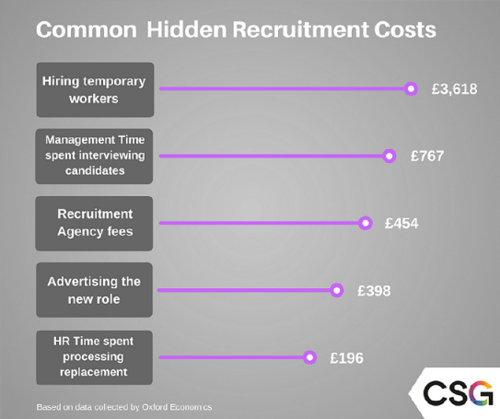Drop off your CV
We'd love to hear from you. Send us your CV and one of our specialist consultants will be in touch.

In an age of infinite choice, everyone wants 'quick fix' solutions to their problems, and recruitment is no different.
Although most of us realise that recruiting can be both time-consuming and expensive – and particularly so for senior-level roles, where niche skills and managerial experience are in high demand – the sheer extent of hidden costs usually comes as a surprise to the people we work with.
The issues we touch on in this post don’t leap out as direct or even connected costs, but the old adage ‘time is money’ rings true when it comes to recruitment. At first glance it may seem faster and cheaper to run a recruitment drive in-house, but many business owners don’t realise all of the time and productivity they squander hunting down the perfect candidate, only to have their offer rejected – which happens 50% of the time. In this post we’ve highlighted just some of these lesser known costs.

It may surprise you to learn that Oxford Economics estimate that it costs £30,614 to replace members of staff. There are obvious reasons for this like the dip in productivity while a replacement employee learns the ropes and the cost of recruiting and absorbing a new starter. But what about the deeper implications for the business?
When you keep the recruitment process in-house, someone will have to write a job description, which may seem straightforward at first but can turn out to be a black hole for your time and money.
Even if your job description is detailed and specific, people who don’t meet your requirements will still apply and it will take considerable time to sift through these to get to the standouts, assuming there are any. If there aren’t you may have to run an alternative advertisement, wasting more time and resources.
In practical terms, getting your advertisement in front of as many relevant candidates as possible is no easy task. Especially at executive and senior levels; sending an advertisement out on general job boards and hoping for the best isn’t going to cut it. The best candidates are often settled in favourable positions so to lure them out you need to convince them that you can offer something unique – no mean feat.
A lot of companies have realised the importance of company culture and responded by throwing money at induction and training programmes to teach new starters company values and standard practices. Imagine how costly this becomes considering that new starters are 50% more likely to leave in their first year than your existing team.
Without guidance on salary expectations, candidate motivations, and personal drivers, a good candidate on paper can be demotivated before they even start, by getting their offer wrong, or through poor handling of the interview/on-boarding process.
Candidates are temperamental because looking for a new job is a stressful and often emotionally loaded time. If you don’t have guidance on salary expectations, motivations and personal drivers, it’s likely you’ll put the candidate off. Interviews are like a game of poker, with both sides playing their cards close to the chest. All of the leading advice tells candidates not to mention figures until late in the recruitment process, but this leaves room for you to spend weeks courting a client who never would have been in a position to accept your offer. If you don’t understand their motivations and personal drivers then again you run the risk of wasting your time and theirs because you’ve both got the wrong end of the stick.
Even if you get through these tricky negotiations, if the new starter hasn’t enjoyed the hiring process, they will invest 15% less discretionary effort on their work and are 38% less likely to stay. This means you would have to slog through the entire hiring process again in a loop that would make Ground Hog Day look like a hoot.
When you consider candidates based on how they will fit into your company culture, roughly 35% will fit the bill. This is down to a cocktail of factors beyond your control such as previous knowledge and training, work ethic, personality and what the candidate wants from their role. Finding out who will fit in, while tricky, is key to employee retention and overall productivity. We spend a third of our waking lives working after all!
Often when we attend interviews, we start to imagine what our life within that company could be – like planning your wedding when you’ve been on a first date! And like a date, we’re always going to be on the look-out for red flags no matter how idealistic we may be.
Similarly, 18% of people who have had a bad experience will stop using the company in the future, which loses you a potential customer/client.
People talk, and we’re much more likely to complain than we are to praise; 33% of people will share this negative experience with their friends which will lessen your candidate pool even further.
While it’s all well and good having strict social media policies for your existing employees and carefully monitoring your company’s online presence, this could all be scuppered when people catch sight of rants from irritated near-hires. 12% will share the bad experience on social media.
How do you get through the bad apples to find the cider? In many cases, the answer might be to seek external recruitment expertise. Dedicated recruiters have large networks of clients and candidates to hand, and, more importantly, have the experience and knowledge of how best to connect them.
A good recruitment partner will consider not just the skills and experience of a candidate, but also the cultural and motivational fit with a vacancy as well. A recruiter also opens up new methods to reach the best talent in the market. While traditional recruitment paths such as job advertisements only target up to a fifth of the market, our targeted headhunt approach gives you access to the talent market in its entirety, including the best performers who are rarely actively looking for work.
There are many benefits to partnering with an external recruitment partner; using an existing network of contacts, the ability to quickly establish new ones, increasing your chances of attracting someone once you’ve found them, and minimising the number of distractions for your own employees.
If you feel that your talent acquisition strategy isn’t up to scratch for 2017 or if you’d just like advice on how your industry is shaping up, contact CSG at clients@csgtalent.com or at +44 (0) 333 323 2000.